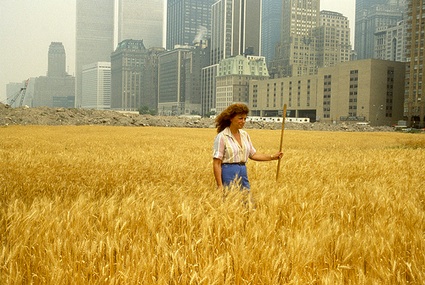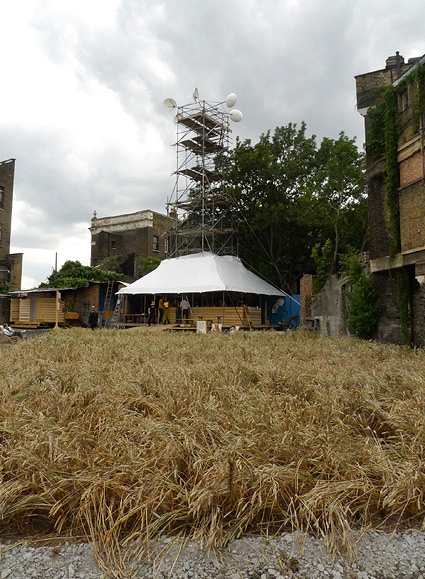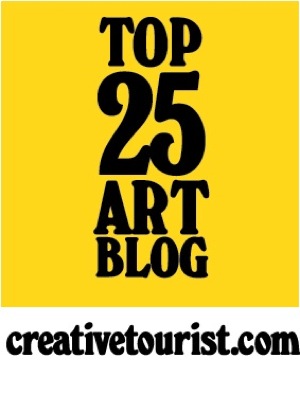
I recently went to check out the Hayward Gallery’s newest exhibition,
Walking in My Mind. Described as “an adventure into the artist’s imagination” this installation-based show brings together work by ten contemporary artists to investigate ideas of creativity, consciousness, perception, thought, emotion and psychological space. It’s certainly an exhibition full of surprises: walking through the galleries feels like tiptoeing through a surreal wonderland of imaginative spaces.
The exhibition kicks off with Yoshitomo Nara’s delightful installation
My Drawing Room - a down-at-heel wendy house complete with a sign announcing ‘Place Like Home’. Peeping through the tiny, dolls-house windows, we can observe all the minutiae of a perfectly-realised personal space: a muddle of scattered drawings, comic books, childhood treasures, and kitsch
kawaii figurines. Inspired by the artist’s student room, and infused with a nostalgia for the past, it is both an intriguing insight into Nara’s influences and creative processes, and a compelling vision of the artist’s mind as a private, detached, personal space which we can glimpse from the outside but never actually enter. In the same gallery,
Studio Wall Drawings, an ongoing series of works on paper by Keith Tyson, occupies similarly personal territory, creating “a space somewhere between a map, a poem, a diary and a painting’” Presented in a single vast expanse, these colourful and extrovert drawings are like a series of mini-narratives, allowing us to glimpse the artist’s lively thought process at work.
Things take a stranger turn as we head upstairs into the upper galleries, alongside works from Charles Avery’s fascinating project
The Islanders: the systematic and detailed investigation of an imaginary island invented by the artist himself. Here, maps are accompanied by drawings and “specimens” of the island’s bizarre flora and fauna presented in a series of vitrines, whilst outside on one of the terraces is the
Eternity Chamber - a sinister funfair kiosk with a mirrored interior which we glimpse through tightly padlocked doors. But all this looks positively ordinary compared with Thomas Hirschorn’s
Cavemanman - a fascinating sculptural environment consisting of a network of tunnels, all constructed from cardboard and yards of brown parcel tape. Clambering through these hidden spaces, encountering cave-like chambers papered with found images and philosophical writings is a truly otherworldly experience: bundles of silver ‘dynamite’ are wired-up to tinfoil-covered shop window dummies, creating a strange and deeply disorientating vision of inner space oddly reminiscent of the set of a long-forgotten episode of Doctor Who. And next up is another weird and discomfiting representation of cerebral space - Jason Rhoades sprawling installation
The Creation Myth. Here, the brain is figured as a control centre surrounded by a chaos of computer screens, televisions and sound systems, linked by a complex network of circuit boards and intertwining cables, and interspersed with all manner of unexpected elements from plastic buckets to pornographic images to a toy train to a massage chair.
So far, so Freudian. But Yayoi Kusama’s playfully trippy polka-dot installation provides a welcome change of pace: her red and white landscape is a dizzy, joyful Alice-in-Wonderland space, spilling out onto an outdoor terrace where on undulating toadstool-spotted structures are scattered across a surface of brilliant green artificial grass. The same childlike fairy-tale feel is reflected in Chiharu Shiota’s
After the Dream, albeit with a nightmare twist: in this space, an intricate spiderweb of black thread surrounds a circle of five long white dresses which appear to hold hands as they float above ground like a malevolent cat’s cradle.
Finally, Pipilotti Rist provides the perfect conclusion to the exhibition - a strange, dark, dreamlike space where starry lights float by accompanied by a succession of projections of giant, disembodied body parts which drift aimlessly by. As these images appear and disappear, a spectral voice coos a sequence of phrases like “you are a butterflower,” “you are a molecule,” and (our particular favourite) “you are a woman-mouse” in an enjoyable parody of recorded relaxation sequences. Like the rest of the installations in this offbeat exhibition, experiencing Rist’s imaginative space is both uncanny and bewildering, yet here the unearthly atmosphere is nicely balanced by the artist’s characteristic sense of humour.
For me,
Walking in My Mind is a compelling exploration of the artist’s imagination, and an exhibition I’d definitely recommend to anyone. Interestingly though, the show has won mixed reviews:
Laura Cumming for The Observer dismissed it as little more than the “summer blockbuster” of the contemporary art world, characterising it as “a lacklustre funfair”. However, there has been plenty of praise for the exhibition from the blogosphere:
webcowgirl calls it “
deliciously trippy and completely worth the cost of admission” whilst
Susie Bubble also gave the exhibition
a thumbs up. I’d agree with them both:
Walking in My Mind is a brilliantly bizarre encounter - the utterly strange experience of walking out of the exhibition into the gallery shop, feeling giddy and peculiar, is worth it alone. Truly mind-altering, in every sense.
[photo via ffffound]




























